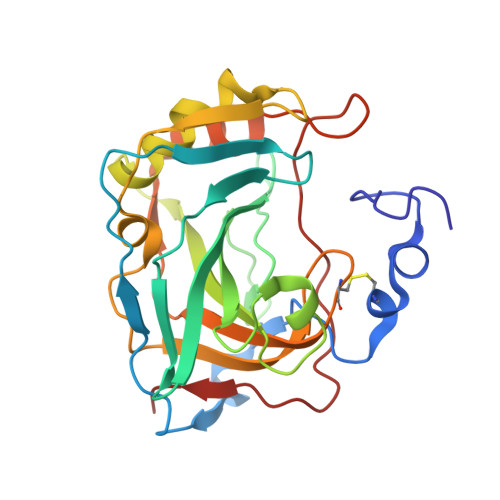Crystal structure of the catalytic domain of the tumor-associated human carbonic anhydrase IX.
Alterio, V., Hilvo, M., Di Fiore, A., Supuran, C.T., Pan, P., Parkkila, S., Scaloni, A., Pastorek, J., Pastorekova, S., Pedone, C., Scozzafava, A., Monti, S.M., De Simone, G.(2009) Proc Natl Acad Sci U S A 106: 16233-16238
- PubMed: 19805286
- DOI: https://doi.org/10.1073/pnas.0908301106
- Primary Citation of Related Structures:
3IAI - PubMed Abstract:
Carbonic anhydrase (CA) IX is a plasma membrane-associated member of the alpha-CA enzyme family, which is involved in solid tumor acidification. It is a marker of tumor hypoxia and a prognostic factor in several human cancers. An aberrant increase in CA IX expression in chronic hypoxia and during development of various carcinomas contributes to tumorigenesis through at least two mechanisms: pH regulation and cell adhesion control. Here we report the X-ray structure of the catalytic domain of CA IX in complex with a classical, clinically used sulfonamide inhibitor, acetazolamide. The structure reveals a typical alpha-CA fold, which significantly differs from the other CA isozymes when the protein quaternary structure is considered. Thus, two catalytic domains of CA IX associate to form a dimer, which is stabilized by the formation of an intermolecular disulfide bond. The active site clefts and the PG domains are located on one face of the dimer, while the C-termini are located on the opposite face to facilitate protein anchoring to the cell membrane. A correlation between the three-dimensional structure and the physiological role of the enzyme is here suggested, based on the measurement of the pH profile of the catalytic activity for the physiological reaction, CO(2) hydration to bicarbonate and protons. On the basis of the structural differences observed between CA IX and the other membrane-associated alpha-CAs, further prospects for the rational drug design of isozyme-specific CA inhibitors are proposed, given that inhibition of this enzyme shows antitumor activity both in vitro and in vivo.
Organizational Affiliation:
Istituto di Biostrutture e Bioimmagini-CNR, via Mezzocannone 16, 80134 Naples, Italy.




















